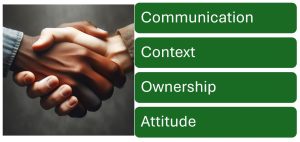 Preparing to Learn
Preparing to Learn
What is Collaboration?
We offered several definitions of collaboration in this module’s introduction. When you think about collaboration in special education, how do you define it? What are the most important behaviors that lead to effective collaboration? Use the resource below to reflect on your understanding of collaboration, what aspects you value the most, and what you would like to learn about collaboration in special education.
Background and History of Collaboration
Traditional Family Involvement in Education
During colonial times and the early 1900s, parents had little interaction with the educational system. In 1995, Welch and Sheridan noted that parents sent children to school to learn academic skills during that time in educational history. Parents educated their children regarding moral principles in the home setting. Parents entrusted their children’s Education to schools and did not participate in the children’s Education. Schools viewed the school as their territory, and teachers viewed parents who tried to become active in the school setting as interfering.
Some parents resisted this approach to Education and subsequently formed the National Parent-Teacher Association (PTA) on February 17, 1897, in Washington, D.C. Today, there are more than 6.5 million members of the National PTA, the largest child advocacy organization in the United States. Welch and Sheridan reported that parents continued to assume a relatively “hands-off” approach to Education until the late 1960s and early 1970s when economic and political factors induced parents to change their views regarding their involvement in Education.
Collaborating With Families in Education
One definition of Collaboration is forming a partnership for working and interacting with families in Education. While it always hasn’t been this way, the current view is that parents and families should be included as active members of the educational system. A partnership philosophy based on Collaboration acknowledges that parents’ contributions should be as valuable as academic team members’ contributions. Educators and administrators possess educational information and expertise, but parents are the student’s experts. They have equally critical information regarding the home system as educators have academically.
When schools adopt an attitude of Collaboration with parents, schools pursue their parental participation in Education. When parents and educators assume a collaborative philosophy, it gives parents equal status with the school for their children’s education decision-making.
Collaboration allows parents and educators to work together to improve their children’s Education and the entire educational system. One characteristic of Collaboration is that individuals learn from one another and pool their knowledge and skills to support a common focus. The result is an improvement in student education across the school.
The quality of the parent-school Collaboration depends on communication between parents and educators. Maintaining open communication is likely to result in a healthy balanced partnership. When schools seek to build Collaboration and partnerships to involve parents, the students ultimately benefit. Schools must acknowledge that Collaboration can not be established during one interaction or activity; instead, it is evidenced and developed over time and through multiple exchanges. To show Collaboration, parents and educators learn that trustworthy relationships form the foundation of in-depth, long-term Collaboration.
Potential Benefits of Parent Collaboration

Successful Collaboration between parents and professionals has many benefits, such as improved communication between parents and educators. In addition, effective Collaboration allows both to better understand what occurs across each others’ settings. This, in turn, enables parents and educators to better understand children’s backgrounds and current levels of functioning.
Establishing a partnership also allows for “joint ownership” of problems and concerns and a joint commitment toward educational and behavioral goals for students. Parents and teachers become collaborators as they work toward student goals. Working together improves relationships between teachers and parents as they better understand children’s behavior across home and school settings.
Students benefit from the parent-teacher Collaboration process as well. Students tend to develop a better attitude toward school and improve performance in and out of the classroom when families are involved. Students also get along better with teachers and strengthen their academic skills.
Factors Influencing Collaboration
Bronfrenbrenner et al. proposed Ecological theory, which defines a child within the context of the microsystem, mesosystem, exosystem, and macrosystem interactions. Bronfenbrenner presents the Ecological Theory as a graphic of concentric circles to illustrate the areas that influence the child from immediate to general.
The microsystem includes the child’s immediate environment, such as when a child is in a classroom or home. The next circle, or the mesosystem, is the interactive systems in the child’s life, such as between home and school. The exosystem is not as immediate to the child but still influences the child’s life. Examples might be the parent’s workplace or the community. Lastly, the macrosystem is defined as the broader society, which can combine community, cultural, state, federal, or even global events. Bronfenbruner’s framework describes how one another influences the various systems in a child’s life.
Family-Related Factors in Developing Collaboration
Family-related factors influence how a family interacts with educators. The quality of the interaction is first affected by the family’s experiences with going to school. Was the parent or family treated as being in the way or unwelcome? Did they experience school as a humiliating or anxiety-producing place?
Alternatively, were the parents comfortable when they went to school? Has the family already been actively involved with the school? Family members’ past experiences with the school will influence how likely the family will feel accepted as an academic partner
Other factors that can influence Collaboration are found under the broad umbrella of family culture. As used here, culture extends beyond race and ethnicity, including acculturation level, beliefs, values, and expectations.
The acculturation level concerns families’ adjustment to the immediate culture when they are not originally from the United States or new to a particular region. Suppose they come from a place where the educational system varies considerably from their new surroundings. In that case, adjusting to the local norms regarding parental involvement with Education may take time. Some families might not view their role as active participants and may leave most decisions and actions to educators. In contrast, others might be actively directive in working with educators.
Family culture includes beliefs, values, what parents expect from the school, and how to interact with the school system. Whether families are first-time parents or parents who have been involved in the educational system long enough to see the significant changes in roles for parents in Education, families can require time to adjust to their new positions.
 Critical Perspective
Critical Perspective
Family and Community Experiences with Special Education
American public education has a long history of structural racism that has resulted in disparities in student outcomes, and this is no less true within special education. As you read the resources below, consider how this factors into the perceived risks for diverse families navigating the special education system with their children. Would you trust your child’s school not to replicate discriminatory practices? How might you, as an educator, rethink your communication strategies to acknowledge the validity of concerns for students of color and their families?
- Equity in IDEA: Why racial disparities are increasing in special ed programs: article describing the racial implications of over- and under-identification in special education
- OSEP Fast Facts: Race and Ethnicity of Children with Disabilities Served under IDEA Part B: data showing the correlation between race and identification in the 13 Disability Types listed under the IDEA
- Hand In Hand for OSEP Fast Facts: Race and Ethnicity of Children with Disabilities Served under IDEA Part B: guide for navigating the data provided in the above link
School-Related Factors
The school is a dynamic system composed of multiple individuals and influenced by numerous forces. (e.g., culture, economic conditions, politics). When considering school-related factors that may affect the nature of Collaboration, it is vital to consider both variables related to individuals within the school and building-specific traits and characteristics.
Concerning school personnel, these individuals acquire beliefs, values, and expectations influenced by various cultural, economic, and political influences. These beliefs, deals, and expectations evolve over time and impact interactions with parents. In addition, just as parents’ behaviors are influenced by experiences with the school, teachers’ behaviors are influenced by their prior experiences with parents.
The size and organizational structure of the school may influence the degree to which parents feel comfortable. Generally, a larger school is less personal, which may cause parents to feel somewhat overwhelmed, resulting in less contact and Collaboration with the school.
The organizational structure also influences how parents interact with school personnel. For example, are teachers and administrators readily available? Are there individuals who take it upon themselves to make regular contact with parents? Some school administrators may encourage teachers to maintain regular contact with parents. In contrast, others may value a top-down approach in which parent contact occurs through administrator-initiated actions and activities (e.g., newsletters and organized meetings). Some schools are warmer, more inclusive, and more family-friendly than others. Multiple factors influence how a school “feels” to parents and students, making pinpointing salient factors challenging.
Community-Related Factors
Community factors influencing interactions between parents and educators are challenging to isolate, given their identification across multiple systems. However, one must recognize the powerful influence of the community in shaping individual and systemic behaviors.
Behaviors, attitudes, and values transmitted from individuals in the home and school settings culminate in a message that guides community behaviors and actions, influencing individual parents and teachers engaged in Collaboration. These may be based on religious, political, or other influences and .may vary over time.
In addition to influencing how parents and educators interact, the community can support or hinder goals and objectives identified collectively by parents and educators. For example, if parents and teachers agree that having an after-school program might help to reduce problems related to latchkey children (i.e., children who care for themselves after school), will the community embrace this plan? Does it offer support to make the vision a reality? Do role models exist in the community to encourage more advanced Collaboration? Each community has a history that guides immediate behavior, affecting future interactions between various systems and individuals. This broad-based system is pivotal and cannot be underestimated concerning its power in driving interactions.
Approaches to Fostering Collaboration
Underlying Assumptions, Roles, and Responsibilities
The educational system has called on parents to actively participate in general and special education processes. Parents are increasingly becoming more involved in planning and decision-making at the local, district, and state levels. In addition to participating in traditional activities such as parent-teacher conferences and back-to-school nights, parental involvement occurs through volunteering, planning, and serving on various committees.
In addition to these responsibilities, parents of children who are identified with specific disabilities are involved in assessing and identifying their children’s particular strengths and limitations, as well as in co-constructing and facilitating their children’s IEPs.
Parent involvement also occurs in the home and community. When parents read with their children, observe and participate in play, and support homework completion, this parent involvement supports their children’s Education. It is assigned to parents and educators to identify meaningful ways parents can participate in their children’s Education. Suppose parents and educators engage in an educational partnership. In that case, team members will collectively identify and use specific areas of expertise that each member brings to the collaboration process as they progress toward a mutually determined set of goals and objectives.
Furthermore, if a collaborative philosophy guides interactions, parents and educators will seek ways in which school system members can support the home system.
How to Involve Families in Education
Although state and federal legislation mandates specify roles, rights, and responsibilities for parents in Education, they do not prescribe specific means for establishing relationships between the home and school settings. Building a partnership is a complex process that does not follow a “cookbook” approach; instead, fostering this relationship is a process that must be approached with care based on a specific guiding philosophy.
Collaboration to work together toward achieving mutually determined educational goals for all students. Many have adopted a partnership philosophy as parents, educators, and other professionals (e.g., speech pathologists) have worked toward a student-focused philosophy guiding their approach to interacting with one another.
Collaboration is a long-term relationship based on parents and educators sharing resources, ideas, decision-making power, and ownership for mutually determined home and school-based educational curricula goals.
Collaboration in Education allows parents to be more intricately involved in school-based educational processes to develop Collaboration. Collaboration is a legal mandate and a necessary part of the success in fully providing for the inclusion of children with special needs. Over the years, several research studies have strongly indicated that students’ educational progress is significantly improved when families and schools work collaboratively with the student as their focus.
Collaboration in Special Education
Effective Collaboration between educators and families is critical to providing quality education for students with special needs. Educators’ role is to provide the individualized instruction, and support students need to succeed.
The University of Kansas published a study that showed that Collaboration between general and special education teachers significantly improves the educational success of students with disabilities.
Data compiled from 700 schools across the country found that when teachers worked Collaboratively, students with disabilities made more progress in academic subjects than those who did not experience collaborative teaching. Teachers who work together share resources and ideas, leading to more effective instruction for all students. In other words, when educators, parents, and school professionals work together, the outcomes result in an education where students can receive the individualized attention and support they need. Furthermore, close Collaboration helps ensure that families and educators are on the same page regarding student goals and progress.
What is Collaboration in Special Education?
In special Education, Collaboration is loosely defined as when two or more family and school individuals work together with a focus on the student. Parents and educators can develop Collaboration goals with face-to-face interaction, online communication, or a combination. Special educators also coordinate Collaboration with other professionals, such as speech and occupational therapists, to best meet the needs of their students.
Collaboration is essential in Special Education because it allows professionals to share their expertise and knowledge about working with students with disabilities. It also enables team members to bounce ideas off each other and find creative solutions to problems.
What role does Collaboration Play in Special Education Services?
Special Education is unique because a team approach is necessary to support students with disabilities. Parents, educators, sta, and administrators are all essential to developing and carrying out Individualized Education Plans (IEPs). While each team member brings different skills and knowledge, the group’s Collaborative efforts ensure successful student
outcomes. Close Collaboration between stakeholders keeps educators and families on the same page in determining student goals and progress. Collaboration between school and home promotes open communication between home and school to better support students with disabilities.
A strong Collaborative relationship among team members also helps identify and troubleshoot challenges as they occur and allows the opportunity to brainstorm potential solutions. Working together as a team helps build relationships of trust and respect, which are necessary to provide high-quality special education services.
Collaboration as a Special Education Teacher
An important role as a special education teacher is to effectively collaborate with other school professionals and staff who may work with your students. First and foremost, the student should always be the center of your focus and the reason for your decisions. You and the parent are the primary advocates for each student; therefore, the student’s best interests– not the school’s or the staff’s, or the district budget-should be the driving force behind all decisions made regarding the student’s best plan for optimal services.
Issues with Collaboration in Special Education
Of the many components that influence Special Education Collaboration, one of the most critical is developing a positive relationship between the educator and the student with disabilities. Trust must be established between the student and the educator to make sure that students with disabilities can feel they can depend on the educator to have their best interests in mind and that they will receive the instruction and support needed to be successful in school.
Effective communication is another critical component to establishing effective Collaboration in Special Education. Educators need to effectively communicate with each other and families and stakeholders. The special educator coordinates and educates team members so that all are on the same page and stay focused on student progress and needs. This can be challenging, especially when multiple team members are involved in a student’s Education. Tempers can fly when team members disagree with what the student’s primary goals should be. It’s important to remember that each team member has skills and knowledge to contribute, and their view is important to consider. It helps to manage a dispute when you know that each team member is heavily engaged in determining what is best for the student.
Differentiating instruction is a significant issue related to Collaboration in Special Education. Each student is different, has unique needs, and may need individualized instructional approaches. Collaborating educators work together to differentiate instruction based on each student’s needs to ensure all students can access the curriculum and progress toward their educational goals.
Components of Collaboration in Special Education
How can you ensure that your school and team are being effective in their approaches to Collaboration in Special Education? Several components can help you evaluate your school’s needs and strengths. Does your team have a shared understanding of the student’s Individualized Education Program (IEP) goals? Is there open communication between all team members? Do all team members keep a record of both oral and written communication? Does each team member respect the roles and responsibilities of the other team members? Are all team members committed to working toward the student’s best interests? When all team members are unified to dedicate to these criteria, team Collaboration has the components to be successful.
Parent-Teacher Collaboration in Special Education
The development of robust Parent-teacher Collaboration is critical for the success of students with disabilities. When parents and teachers work together, the research indicates that students achieve better outcomes. However, this can be challenging when parents and teachers have different ideas of what the most important goals for the child are. It helps when both parents and teachers should keep this in mind when collaborating. Most importantly, remember that you are both on the same team! You are committed to creating the best possible Education for the child. Understand that the parent’s goals for the child may not match the educators’ goals. Here is where effective communication is vital. In many circumstances, the parents’ goals may be practical and related to the quality of the family’s life. Educators must respect this and consider which goals have more impact on the student and the family, both short-term and long-term. Be respectful of each other’s time and keep the focus on the child’s needs. Our memories are never as good as we think they are. Document, document, document.
Importance of Parent-Teacher Collaboration in Special Education
In the Special Education field, the development of shared parent-teacher Collaboration is vital. When shared Collaboration occurs, parents and teachers know that students with disabilities can receive the best support and education. The benefits of successful parent-teacher Collaboration in Special Education are significant. One outcome of effective Collaboration is that it allows families to be more involved in their child’s Education. It helps them to better understand their child’s needs. From the teacher’s standpoint, teachers can better understand what happens at home. This contributes to both teachers and families having a greater understanding of the student’s strengths and weaknesses. This information can then contribute to creating more customized and effective educational plans.
Parent-teacher Collaboration helps to build stronger relationships between parents and teachers. Strong relationships are essential to ensure that students with special needs receive the best possible support. When parents and teachers work together, they can share ideas, resources, and advice which can make a big difference in a child’s life. Special Education’s focus is to provide educational support to students with disabilities. One of the challenges in Special Education is finding ways to effectively collaborate with parents and professionals to give students the best possible educational experience.
Collaboration and Creating an IEP
Different roles within the IEP team
What are their roles on the team, and how might they collaborate with one or more of the other team members? What are some ways that collaboration fails to occur in the “real world”? What are some ways to address that lack of collaboration? (Examples: multidisciplinary reports as opposed to siloed, separately-submitted reports)
- Parents
- Classroom teacher
- Administrator (principal, vice principal, SPED Director, etc.)
- Social worker
- Counselor
- School nurse
- School psychologist
- Speech language pathologist
- Occupational, music, and/or physical Therapist
- Pediatrician/other medical professional (qualifier—see history)
- Student themselves
- Specialist teacher (music, P.E., etc.)
 Reflection
Reflection
Collaborating Across Roles on an IEP Team
While there are some IEP team roles that are required, there are many additional roles that may be present in order to meet a particular student’s needs. Some of them may be inexperienced working on IEP teams, resulting in ineffective collaboration. As you consider the list of possible IEP team members below, think about what proactive approaches might help the team avoid ineffective collaborations.
- Parent
- Classroom teacher
- Administrator (principal, vice principal, etc.)
- Social worker
- Counselor
- School nurse
- School psychologist
- Speech language pathologist
- Occupational, music, and/or physical therapist
- Pediatrician/other medical professional
- Student
- Specialist teacher (music, P.E., etc.)
References
Microsoft Designer. (2024). Two Hands Shaking. [Digital image]. Retrieved from Microsoft Designer Chat.
